Mrs. T’s Case: Analysis of Medication Error, Ethical and Legal Issues
VerifiedAdded on 2023/06/13
|10
|2476
|299
Case Study
AI Summary
This case study delves into the tragic death of Mrs. T due to a medication error committed by nurses, highlighting the critical need for adherence to legislation, proper scheduling, and ethical principles in healthcare. The analysis covers the specifics of the error—a misread medication order—its impact on patient safety, and proposes a double-checking strategy to prevent future occurrences. It examines violations of the ethical principles of veracity and non-maleficence, particularly focusing on the nurses' failure to report discrepancies. Furthermore, the study underscores the significance of Australian drug legislation, specifically Schedules 2, 3, 4, and 8, in ensuring medication safety and appropriate usage within nursing practice. The conclusion emphasizes the importance of vigilance, ethical conduct, and adherence to legal frameworks to safeguard patient well-being and prevent avoidable medical errors. Desklib offers this case study along with numerous other solved assignments for students.
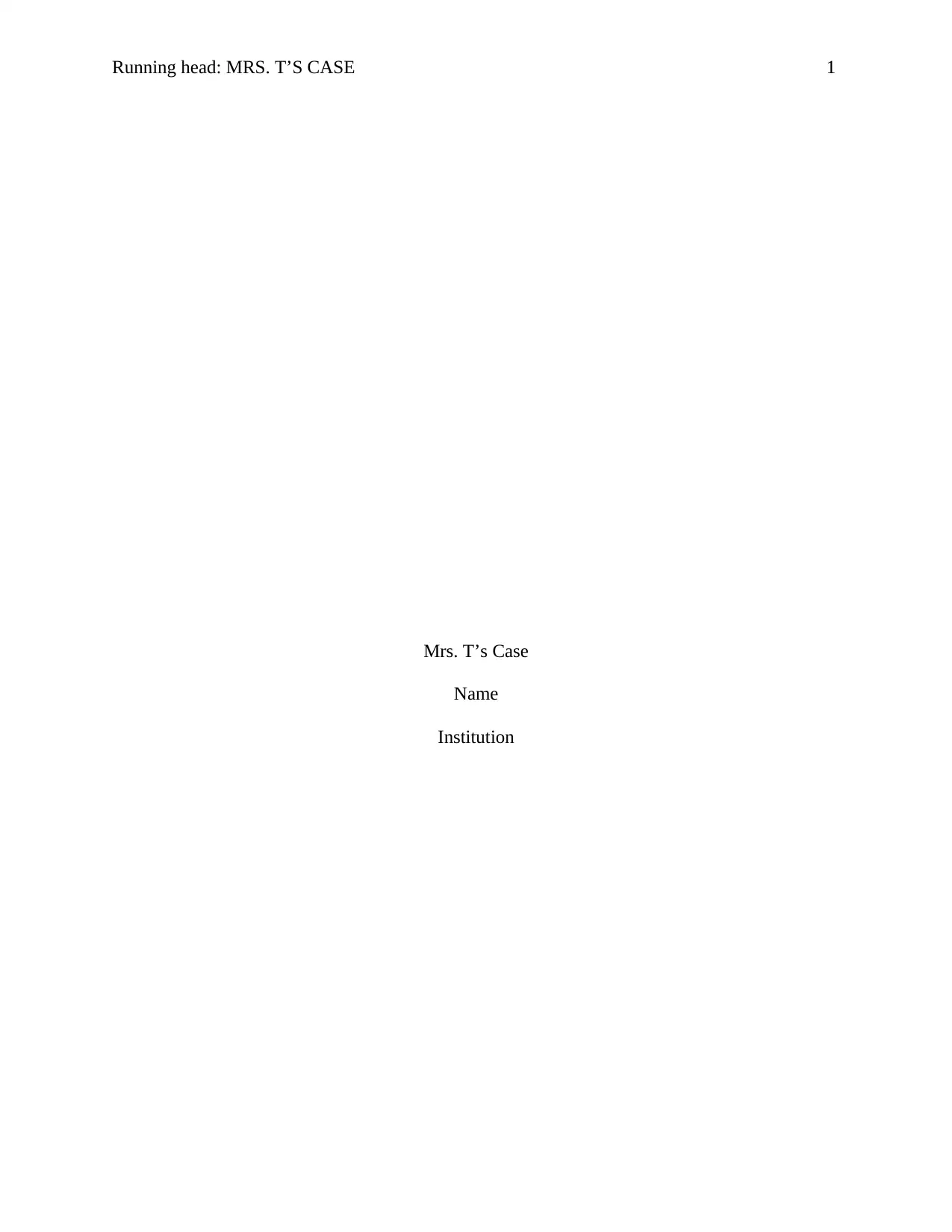
Running head: MRS. T’S CASE 1
Mrs. T’s Case
Name
Institution
Mrs. T’s Case
Name
Institution
Paraphrase This Document
Need a fresh take? Get an instant paraphrase of this document with our AI Paraphraser
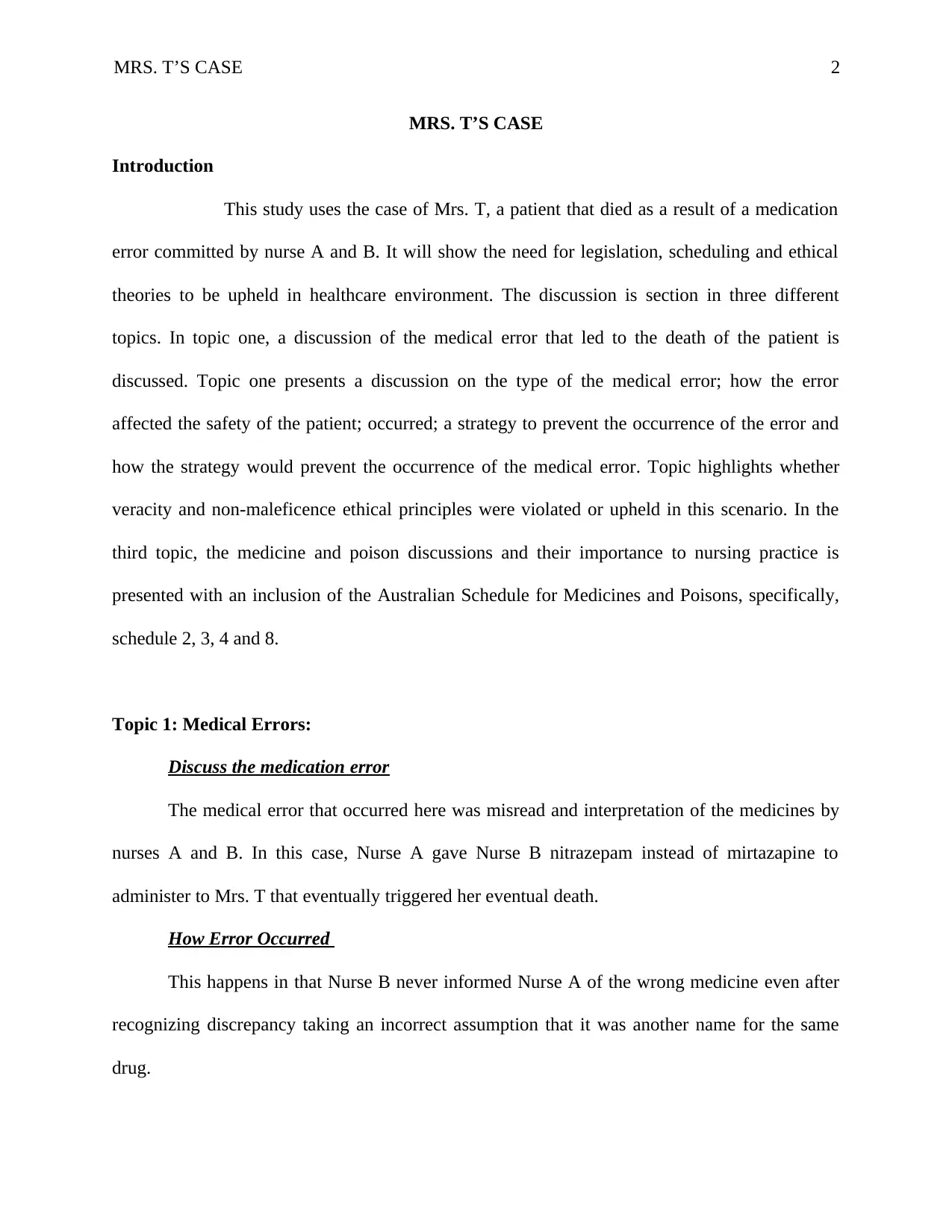
MRS. T’S CASE 2
MRS. T’S CASE
Introduction
This study uses the case of Mrs. T, a patient that died as a result of a medication
error committed by nurse A and B. It will show the need for legislation, scheduling and ethical
theories to be upheld in healthcare environment. The discussion is section in three different
topics. In topic one, a discussion of the medical error that led to the death of the patient is
discussed. Topic one presents a discussion on the type of the medical error; how the error
affected the safety of the patient; occurred; a strategy to prevent the occurrence of the error and
how the strategy would prevent the occurrence of the medical error. Topic highlights whether
veracity and non-maleficence ethical principles were violated or upheld in this scenario. In the
third topic, the medicine and poison discussions and their importance to nursing practice is
presented with an inclusion of the Australian Schedule for Medicines and Poisons, specifically,
schedule 2, 3, 4 and 8.
Topic 1: Medical Errors:
Discuss the medication error
The medical error that occurred here was misread and interpretation of the medicines by
nurses A and B. In this case, Nurse A gave Nurse B nitrazepam instead of mirtazapine to
administer to Mrs. T that eventually triggered her eventual death.
How Error Occurred
This happens in that Nurse B never informed Nurse A of the wrong medicine even after
recognizing discrepancy taking an incorrect assumption that it was another name for the same
drug.
MRS. T’S CASE
Introduction
This study uses the case of Mrs. T, a patient that died as a result of a medication
error committed by nurse A and B. It will show the need for legislation, scheduling and ethical
theories to be upheld in healthcare environment. The discussion is section in three different
topics. In topic one, a discussion of the medical error that led to the death of the patient is
discussed. Topic one presents a discussion on the type of the medical error; how the error
affected the safety of the patient; occurred; a strategy to prevent the occurrence of the error and
how the strategy would prevent the occurrence of the medical error. Topic highlights whether
veracity and non-maleficence ethical principles were violated or upheld in this scenario. In the
third topic, the medicine and poison discussions and their importance to nursing practice is
presented with an inclusion of the Australian Schedule for Medicines and Poisons, specifically,
schedule 2, 3, 4 and 8.
Topic 1: Medical Errors:
Discuss the medication error
The medical error that occurred here was misread and interpretation of the medicines by
nurses A and B. In this case, Nurse A gave Nurse B nitrazepam instead of mirtazapine to
administer to Mrs. T that eventually triggered her eventual death.
How Error Occurred
This happens in that Nurse B never informed Nurse A of the wrong medicine even after
recognizing discrepancy taking an incorrect assumption that it was another name for the same
drug.
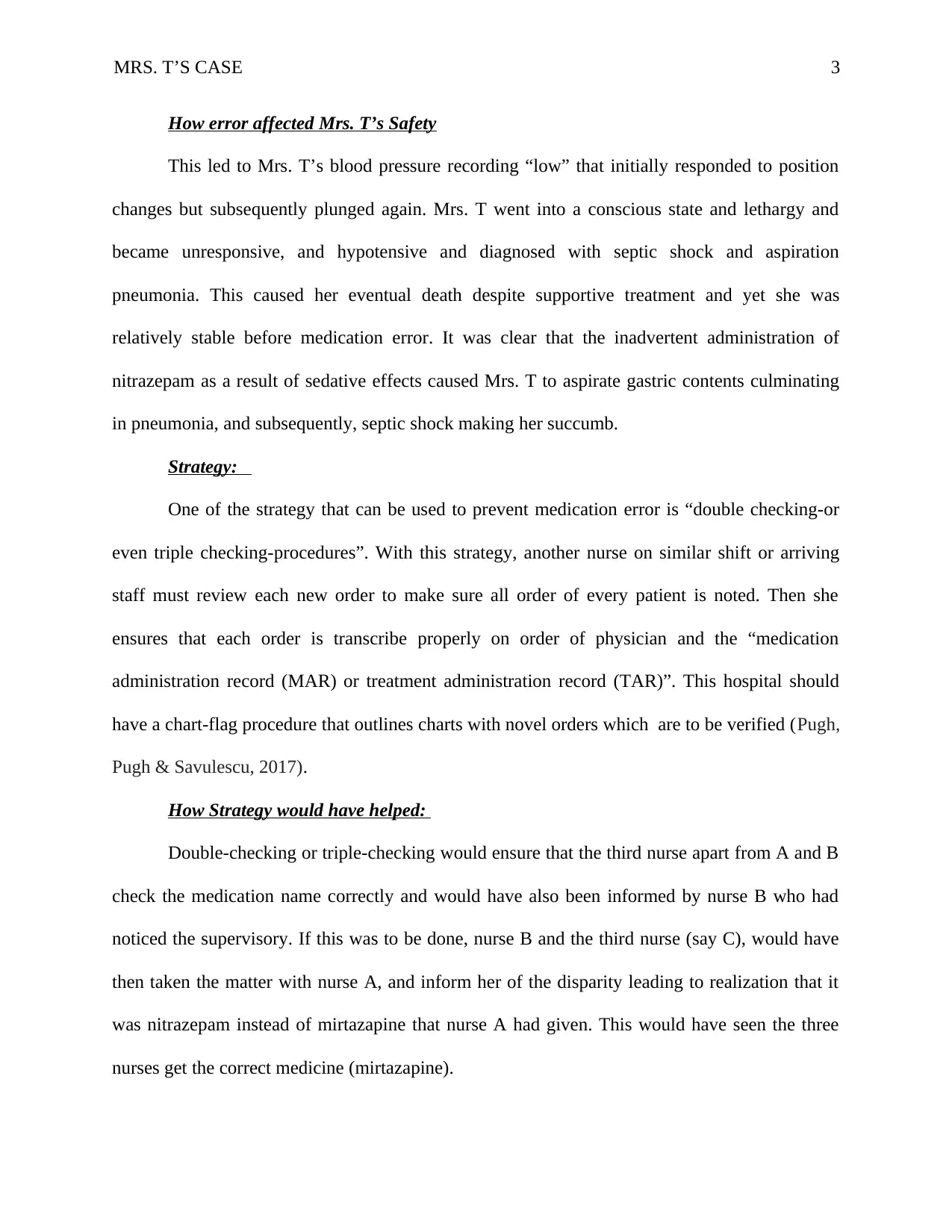
MRS. T’S CASE 3
How error affected Mrs. T’s Safety
This led to Mrs. T’s blood pressure recording “low” that initially responded to position
changes but subsequently plunged again. Mrs. T went into a conscious state and lethargy and
became unresponsive, and hypotensive and diagnosed with septic shock and aspiration
pneumonia. This caused her eventual death despite supportive treatment and yet she was
relatively stable before medication error. It was clear that the inadvertent administration of
nitrazepam as a result of sedative effects caused Mrs. T to aspirate gastric contents culminating
in pneumonia, and subsequently, septic shock making her succumb.
Strategy:
One of the strategy that can be used to prevent medication error is “double checking-or
even triple checking-procedures”. With this strategy, another nurse on similar shift or arriving
staff must review each new order to make sure all order of every patient is noted. Then she
ensures that each order is transcribe properly on order of physician and the “medication
administration record (MAR) or treatment administration record (TAR)”. This hospital should
have a chart-flag procedure that outlines charts with novel orders which are to be verified (Pugh,
Pugh & Savulescu, 2017).
How Strategy would have helped:
Double-checking or triple-checking would ensure that the third nurse apart from A and B
check the medication name correctly and would have also been informed by nurse B who had
noticed the supervisory. If this was to be done, nurse B and the third nurse (say C), would have
then taken the matter with nurse A, and inform her of the disparity leading to realization that it
was nitrazepam instead of mirtazapine that nurse A had given. This would have seen the three
nurses get the correct medicine (mirtazapine).
How error affected Mrs. T’s Safety
This led to Mrs. T’s blood pressure recording “low” that initially responded to position
changes but subsequently plunged again. Mrs. T went into a conscious state and lethargy and
became unresponsive, and hypotensive and diagnosed with septic shock and aspiration
pneumonia. This caused her eventual death despite supportive treatment and yet she was
relatively stable before medication error. It was clear that the inadvertent administration of
nitrazepam as a result of sedative effects caused Mrs. T to aspirate gastric contents culminating
in pneumonia, and subsequently, septic shock making her succumb.
Strategy:
One of the strategy that can be used to prevent medication error is “double checking-or
even triple checking-procedures”. With this strategy, another nurse on similar shift or arriving
staff must review each new order to make sure all order of every patient is noted. Then she
ensures that each order is transcribe properly on order of physician and the “medication
administration record (MAR) or treatment administration record (TAR)”. This hospital should
have a chart-flag procedure that outlines charts with novel orders which are to be verified (Pugh,
Pugh & Savulescu, 2017).
How Strategy would have helped:
Double-checking or triple-checking would ensure that the third nurse apart from A and B
check the medication name correctly and would have also been informed by nurse B who had
noticed the supervisory. If this was to be done, nurse B and the third nurse (say C), would have
then taken the matter with nurse A, and inform her of the disparity leading to realization that it
was nitrazepam instead of mirtazapine that nurse A had given. This would have seen the three
nurses get the correct medicine (mirtazapine).
⊘ This is a preview!⊘
Do you want full access?
Subscribe today to unlock all pages.

Trusted by 1+ million students worldwide
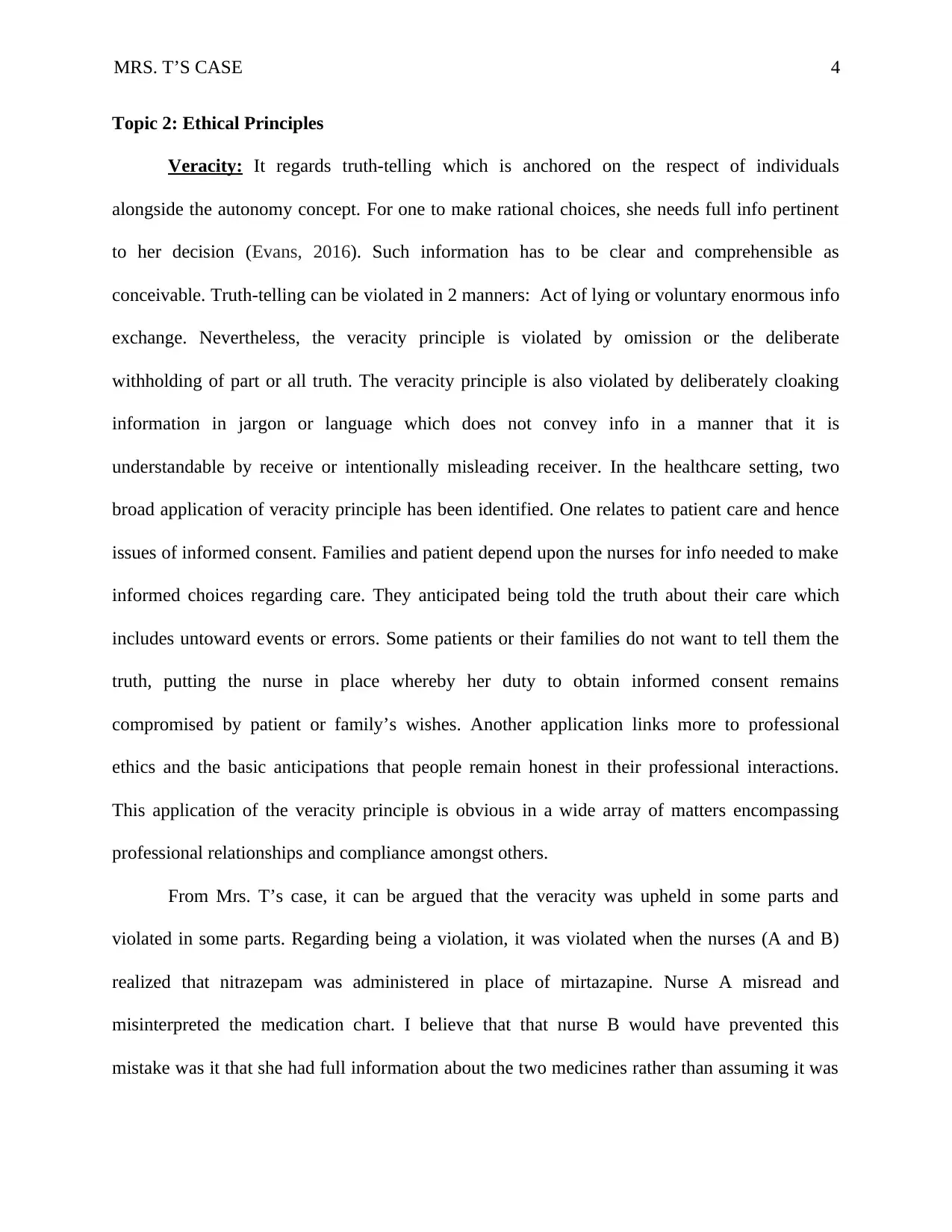
MRS. T’S CASE 4
Topic 2: Ethical Principles
Veracity: It regards truth-telling which is anchored on the respect of individuals
alongside the autonomy concept. For one to make rational choices, she needs full info pertinent
to her decision (Evans, 2016). Such information has to be clear and comprehensible as
conceivable. Truth-telling can be violated in 2 manners: Act of lying or voluntary enormous info
exchange. Nevertheless, the veracity principle is violated by omission or the deliberate
withholding of part or all truth. The veracity principle is also violated by deliberately cloaking
information in jargon or language which does not convey info in a manner that it is
understandable by receive or intentionally misleading receiver. In the healthcare setting, two
broad application of veracity principle has been identified. One relates to patient care and hence
issues of informed consent. Families and patient depend upon the nurses for info needed to make
informed choices regarding care. They anticipated being told the truth about their care which
includes untoward events or errors. Some patients or their families do not want to tell them the
truth, putting the nurse in place whereby her duty to obtain informed consent remains
compromised by patient or family’s wishes. Another application links more to professional
ethics and the basic anticipations that people remain honest in their professional interactions.
This application of the veracity principle is obvious in a wide array of matters encompassing
professional relationships and compliance amongst others.
From Mrs. T’s case, it can be argued that the veracity was upheld in some parts and
violated in some parts. Regarding being a violation, it was violated when the nurses (A and B)
realized that nitrazepam was administered in place of mirtazapine. Nurse A misread and
misinterpreted the medication chart. I believe that that nurse B would have prevented this
mistake was it that she had full information about the two medicines rather than assuming it was
Topic 2: Ethical Principles
Veracity: It regards truth-telling which is anchored on the respect of individuals
alongside the autonomy concept. For one to make rational choices, she needs full info pertinent
to her decision (Evans, 2016). Such information has to be clear and comprehensible as
conceivable. Truth-telling can be violated in 2 manners: Act of lying or voluntary enormous info
exchange. Nevertheless, the veracity principle is violated by omission or the deliberate
withholding of part or all truth. The veracity principle is also violated by deliberately cloaking
information in jargon or language which does not convey info in a manner that it is
understandable by receive or intentionally misleading receiver. In the healthcare setting, two
broad application of veracity principle has been identified. One relates to patient care and hence
issues of informed consent. Families and patient depend upon the nurses for info needed to make
informed choices regarding care. They anticipated being told the truth about their care which
includes untoward events or errors. Some patients or their families do not want to tell them the
truth, putting the nurse in place whereby her duty to obtain informed consent remains
compromised by patient or family’s wishes. Another application links more to professional
ethics and the basic anticipations that people remain honest in their professional interactions.
This application of the veracity principle is obvious in a wide array of matters encompassing
professional relationships and compliance amongst others.
From Mrs. T’s case, it can be argued that the veracity was upheld in some parts and
violated in some parts. Regarding being a violation, it was violated when the nurses (A and B)
realized that nitrazepam was administered in place of mirtazapine. Nurse A misread and
misinterpreted the medication chart. I believe that that nurse B would have prevented this
mistake was it that she had full information about the two medicines rather than assuming it was
Paraphrase This Document
Need a fresh take? Get an instant paraphrase of this document with our AI Paraphraser
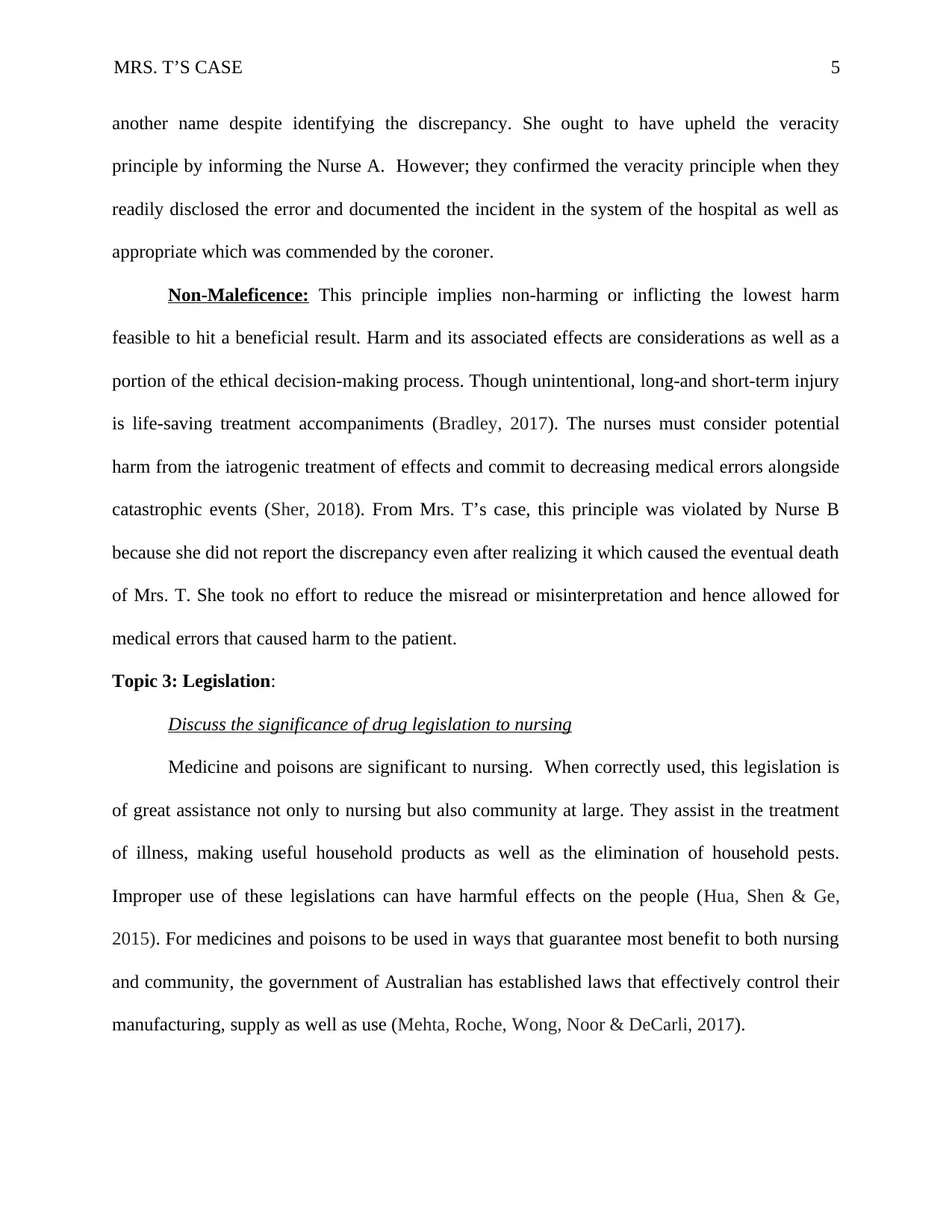
MRS. T’S CASE 5
another name despite identifying the discrepancy. She ought to have upheld the veracity
principle by informing the Nurse A. However; they confirmed the veracity principle when they
readily disclosed the error and documented the incident in the system of the hospital as well as
appropriate which was commended by the coroner.
Non-Maleficence: This principle implies non-harming or inflicting the lowest harm
feasible to hit a beneficial result. Harm and its associated effects are considerations as well as a
portion of the ethical decision-making process. Though unintentional, long-and short-term injury
is life-saving treatment accompaniments (Bradley, 2017). The nurses must consider potential
harm from the iatrogenic treatment of effects and commit to decreasing medical errors alongside
catastrophic events (Sher, 2018). From Mrs. T’s case, this principle was violated by Nurse B
because she did not report the discrepancy even after realizing it which caused the eventual death
of Mrs. T. She took no effort to reduce the misread or misinterpretation and hence allowed for
medical errors that caused harm to the patient.
Topic 3: Legislation:
Discuss the significance of drug legislation to nursing
Medicine and poisons are significant to nursing. When correctly used, this legislation is
of great assistance not only to nursing but also community at large. They assist in the treatment
of illness, making useful household products as well as the elimination of household pests.
Improper use of these legislations can have harmful effects on the people (Hua, Shen & Ge,
2015). For medicines and poisons to be used in ways that guarantee most benefit to both nursing
and community, the government of Australian has established laws that effectively control their
manufacturing, supply as well as use (Mehta, Roche, Wong, Noor & DeCarli, 2017).
another name despite identifying the discrepancy. She ought to have upheld the veracity
principle by informing the Nurse A. However; they confirmed the veracity principle when they
readily disclosed the error and documented the incident in the system of the hospital as well as
appropriate which was commended by the coroner.
Non-Maleficence: This principle implies non-harming or inflicting the lowest harm
feasible to hit a beneficial result. Harm and its associated effects are considerations as well as a
portion of the ethical decision-making process. Though unintentional, long-and short-term injury
is life-saving treatment accompaniments (Bradley, 2017). The nurses must consider potential
harm from the iatrogenic treatment of effects and commit to decreasing medical errors alongside
catastrophic events (Sher, 2018). From Mrs. T’s case, this principle was violated by Nurse B
because she did not report the discrepancy even after realizing it which caused the eventual death
of Mrs. T. She took no effort to reduce the misread or misinterpretation and hence allowed for
medical errors that caused harm to the patient.
Topic 3: Legislation:
Discuss the significance of drug legislation to nursing
Medicine and poisons are significant to nursing. When correctly used, this legislation is
of great assistance not only to nursing but also community at large. They assist in the treatment
of illness, making useful household products as well as the elimination of household pests.
Improper use of these legislations can have harmful effects on the people (Hua, Shen & Ge,
2015). For medicines and poisons to be used in ways that guarantee most benefit to both nursing
and community, the government of Australian has established laws that effectively control their
manufacturing, supply as well as use (Mehta, Roche, Wong, Noor & DeCarli, 2017).
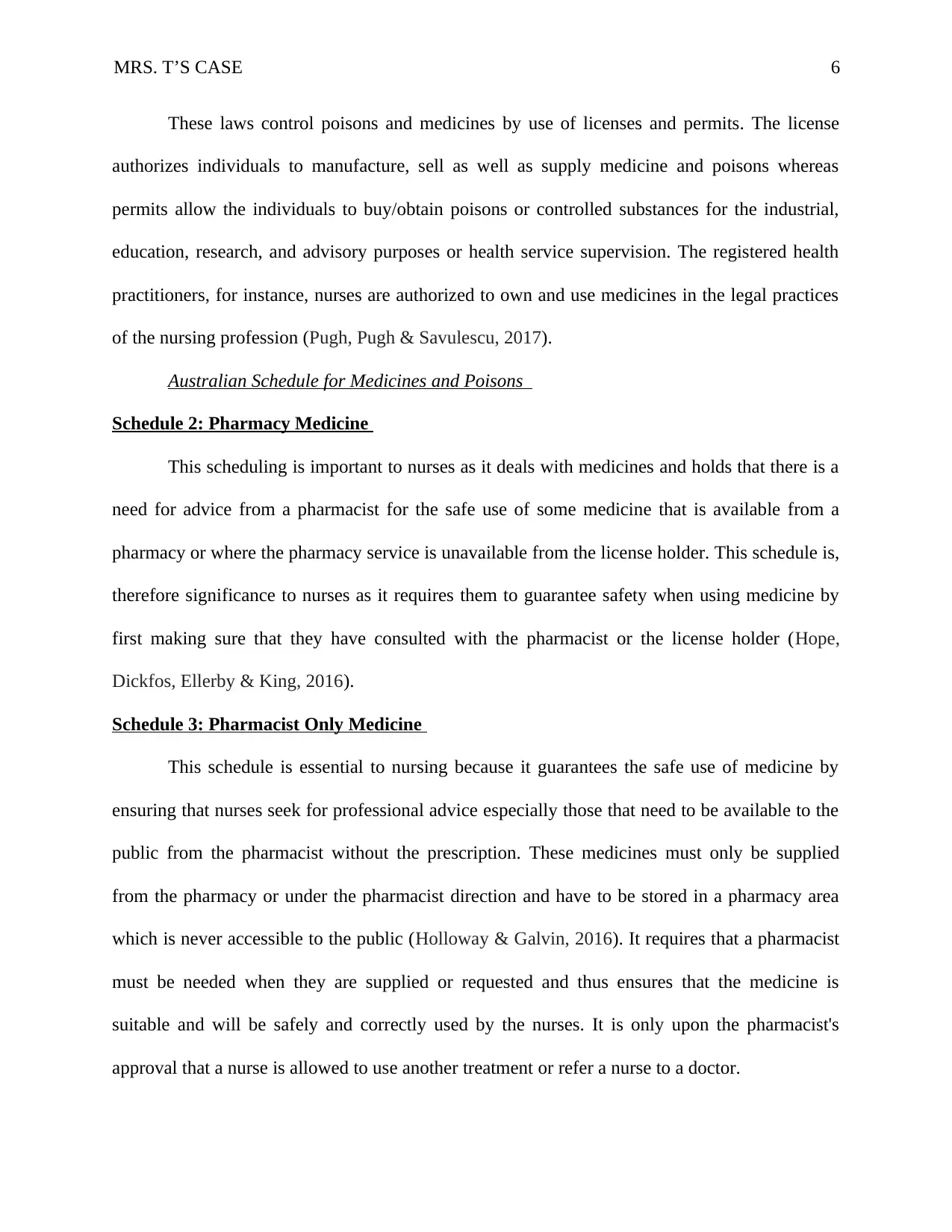
MRS. T’S CASE 6
These laws control poisons and medicines by use of licenses and permits. The license
authorizes individuals to manufacture, sell as well as supply medicine and poisons whereas
permits allow the individuals to buy/obtain poisons or controlled substances for the industrial,
education, research, and advisory purposes or health service supervision. The registered health
practitioners, for instance, nurses are authorized to own and use medicines in the legal practices
of the nursing profession (Pugh, Pugh & Savulescu, 2017).
Australian Schedule for Medicines and Poisons
Schedule 2: Pharmacy Medicine
This scheduling is important to nurses as it deals with medicines and holds that there is a
need for advice from a pharmacist for the safe use of some medicine that is available from a
pharmacy or where the pharmacy service is unavailable from the license holder. This schedule is,
therefore significance to nurses as it requires them to guarantee safety when using medicine by
first making sure that they have consulted with the pharmacist or the license holder (Hope,
Dickfos, Ellerby & King, 2016).
Schedule 3: Pharmacist Only Medicine
This schedule is essential to nursing because it guarantees the safe use of medicine by
ensuring that nurses seek for professional advice especially those that need to be available to the
public from the pharmacist without the prescription. These medicines must only be supplied
from the pharmacy or under the pharmacist direction and have to be stored in a pharmacy area
which is never accessible to the public (Holloway & Galvin, 2016). It requires that a pharmacist
must be needed when they are supplied or requested and thus ensures that the medicine is
suitable and will be safely and correctly used by the nurses. It is only upon the pharmacist's
approval that a nurse is allowed to use another treatment or refer a nurse to a doctor.
These laws control poisons and medicines by use of licenses and permits. The license
authorizes individuals to manufacture, sell as well as supply medicine and poisons whereas
permits allow the individuals to buy/obtain poisons or controlled substances for the industrial,
education, research, and advisory purposes or health service supervision. The registered health
practitioners, for instance, nurses are authorized to own and use medicines in the legal practices
of the nursing profession (Pugh, Pugh & Savulescu, 2017).
Australian Schedule for Medicines and Poisons
Schedule 2: Pharmacy Medicine
This scheduling is important to nurses as it deals with medicines and holds that there is a
need for advice from a pharmacist for the safe use of some medicine that is available from a
pharmacy or where the pharmacy service is unavailable from the license holder. This schedule is,
therefore significance to nurses as it requires them to guarantee safety when using medicine by
first making sure that they have consulted with the pharmacist or the license holder (Hope,
Dickfos, Ellerby & King, 2016).
Schedule 3: Pharmacist Only Medicine
This schedule is essential to nursing because it guarantees the safe use of medicine by
ensuring that nurses seek for professional advice especially those that need to be available to the
public from the pharmacist without the prescription. These medicines must only be supplied
from the pharmacy or under the pharmacist direction and have to be stored in a pharmacy area
which is never accessible to the public (Holloway & Galvin, 2016). It requires that a pharmacist
must be needed when they are supplied or requested and thus ensures that the medicine is
suitable and will be safely and correctly used by the nurses. It is only upon the pharmacist's
approval that a nurse is allowed to use another treatment or refer a nurse to a doctor.
⊘ This is a preview!⊘
Do you want full access?
Subscribe today to unlock all pages.

Trusted by 1+ million students worldwide
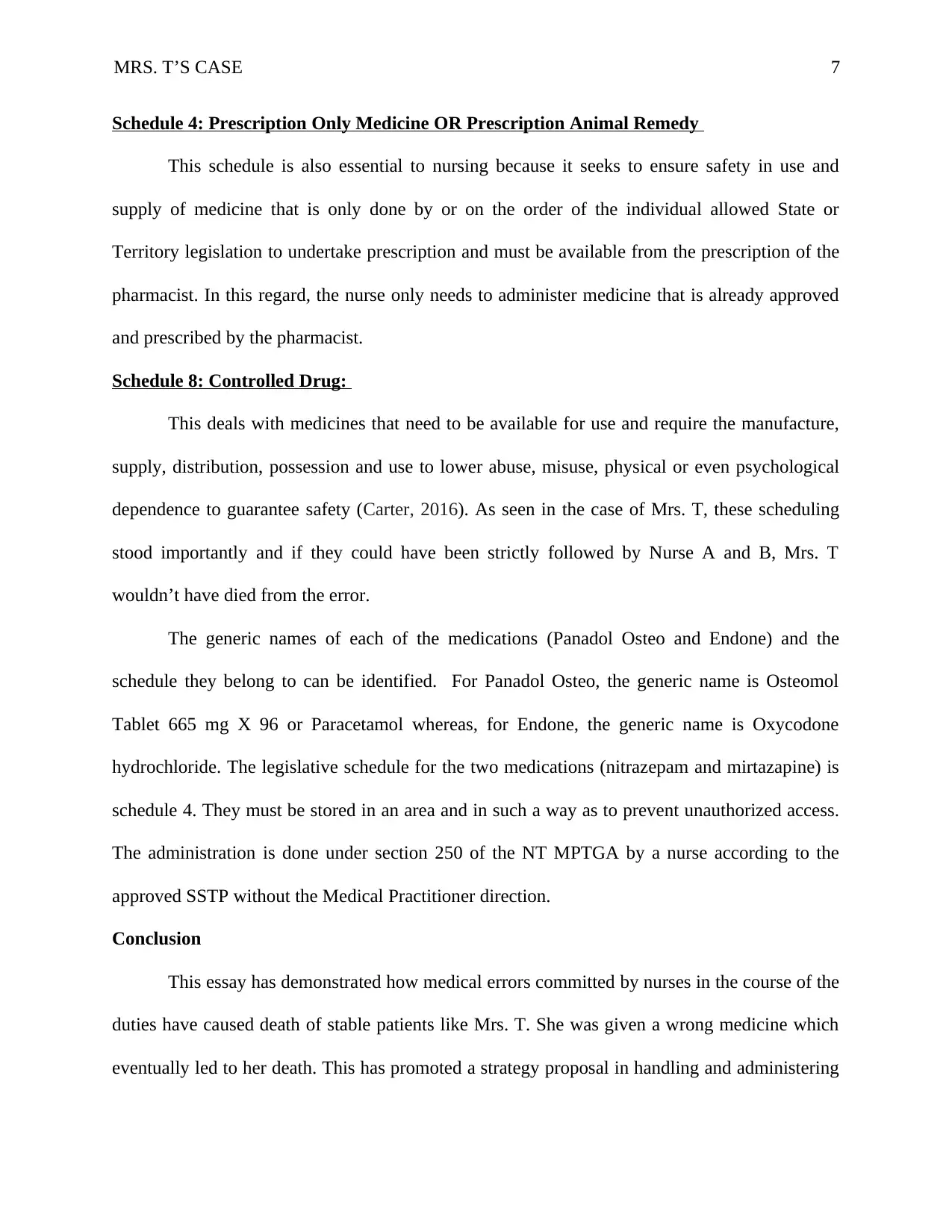
MRS. T’S CASE 7
Schedule 4: Prescription Only Medicine OR Prescription Animal Remedy
This schedule is also essential to nursing because it seeks to ensure safety in use and
supply of medicine that is only done by or on the order of the individual allowed State or
Territory legislation to undertake prescription and must be available from the prescription of the
pharmacist. In this regard, the nurse only needs to administer medicine that is already approved
and prescribed by the pharmacist.
Schedule 8: Controlled Drug:
This deals with medicines that need to be available for use and require the manufacture,
supply, distribution, possession and use to lower abuse, misuse, physical or even psychological
dependence to guarantee safety (Carter, 2016). As seen in the case of Mrs. T, these scheduling
stood importantly and if they could have been strictly followed by Nurse A and B, Mrs. T
wouldn’t have died from the error.
The generic names of each of the medications (Panadol Osteo and Endone) and the
schedule they belong to can be identified. For Panadol Osteo, the generic name is Osteomol
Tablet 665 mg X 96 or Paracetamol whereas, for Endone, the generic name is Oxycodone
hydrochloride. The legislative schedule for the two medications (nitrazepam and mirtazapine) is
schedule 4. They must be stored in an area and in such a way as to prevent unauthorized access.
The administration is done under section 250 of the NT MPTGA by a nurse according to the
approved SSTP without the Medical Practitioner direction.
Conclusion
This essay has demonstrated how medical errors committed by nurses in the course of the
duties have caused death of stable patients like Mrs. T. She was given a wrong medicine which
eventually led to her death. This has promoted a strategy proposal in handling and administering
Schedule 4: Prescription Only Medicine OR Prescription Animal Remedy
This schedule is also essential to nursing because it seeks to ensure safety in use and
supply of medicine that is only done by or on the order of the individual allowed State or
Territory legislation to undertake prescription and must be available from the prescription of the
pharmacist. In this regard, the nurse only needs to administer medicine that is already approved
and prescribed by the pharmacist.
Schedule 8: Controlled Drug:
This deals with medicines that need to be available for use and require the manufacture,
supply, distribution, possession and use to lower abuse, misuse, physical or even psychological
dependence to guarantee safety (Carter, 2016). As seen in the case of Mrs. T, these scheduling
stood importantly and if they could have been strictly followed by Nurse A and B, Mrs. T
wouldn’t have died from the error.
The generic names of each of the medications (Panadol Osteo and Endone) and the
schedule they belong to can be identified. For Panadol Osteo, the generic name is Osteomol
Tablet 665 mg X 96 or Paracetamol whereas, for Endone, the generic name is Oxycodone
hydrochloride. The legislative schedule for the two medications (nitrazepam and mirtazapine) is
schedule 4. They must be stored in an area and in such a way as to prevent unauthorized access.
The administration is done under section 250 of the NT MPTGA by a nurse according to the
approved SSTP without the Medical Practitioner direction.
Conclusion
This essay has demonstrated how medical errors committed by nurses in the course of the
duties have caused death of stable patients like Mrs. T. She was given a wrong medicine which
eventually led to her death. This has promoted a strategy proposal in handling and administering
Paraphrase This Document
Need a fresh take? Get an instant paraphrase of this document with our AI Paraphraser
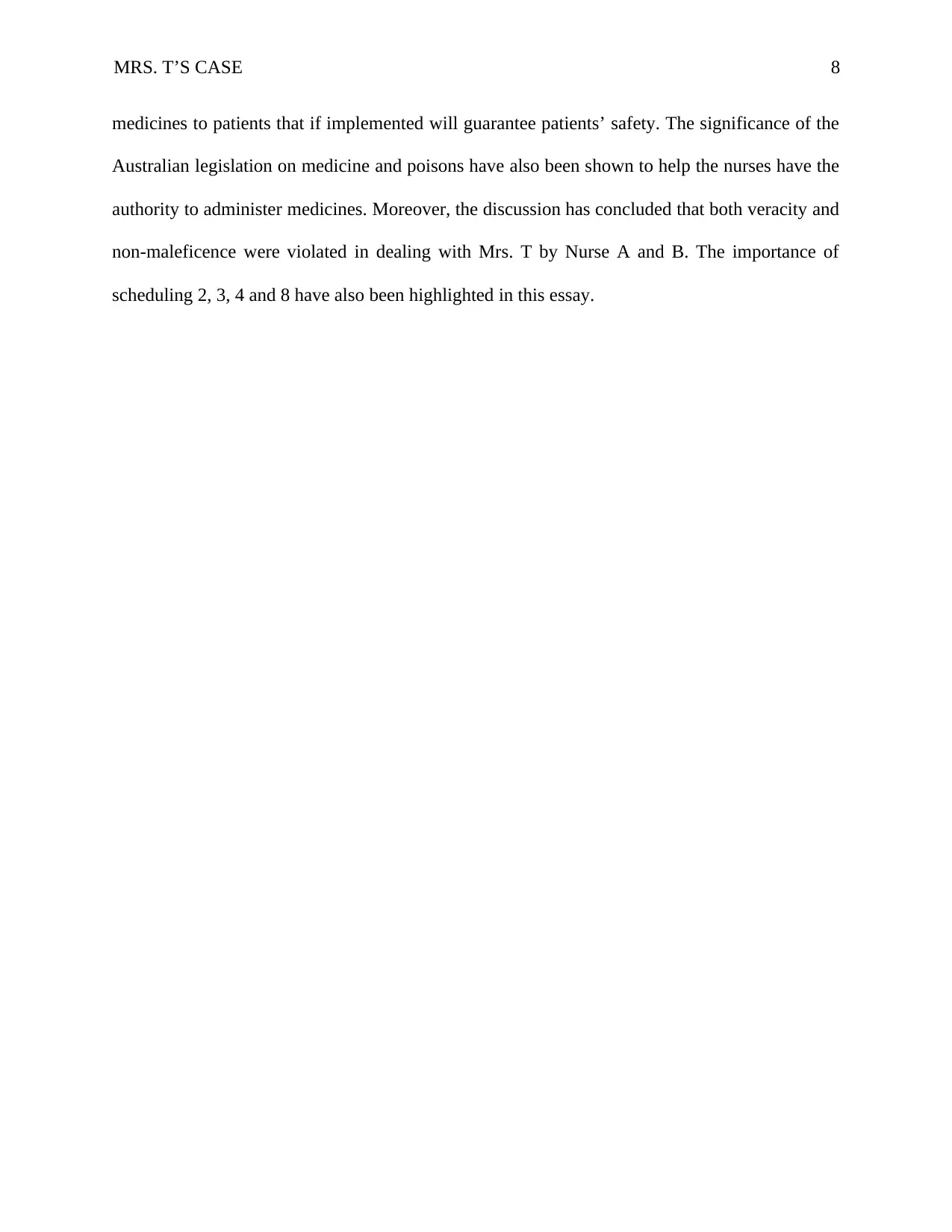
MRS. T’S CASE 8
medicines to patients that if implemented will guarantee patients’ safety. The significance of the
Australian legislation on medicine and poisons have also been shown to help the nurses have the
authority to administer medicines. Moreover, the discussion has concluded that both veracity and
non-maleficence were violated in dealing with Mrs. T by Nurse A and B. The importance of
scheduling 2, 3, 4 and 8 have also been highlighted in this essay.
medicines to patients that if implemented will guarantee patients’ safety. The significance of the
Australian legislation on medicine and poisons have also been shown to help the nurses have the
authority to administer medicines. Moreover, the discussion has concluded that both veracity and
non-maleficence were violated in dealing with Mrs. T by Nurse A and B. The importance of
scheduling 2, 3, 4 and 8 have also been highlighted in this essay.
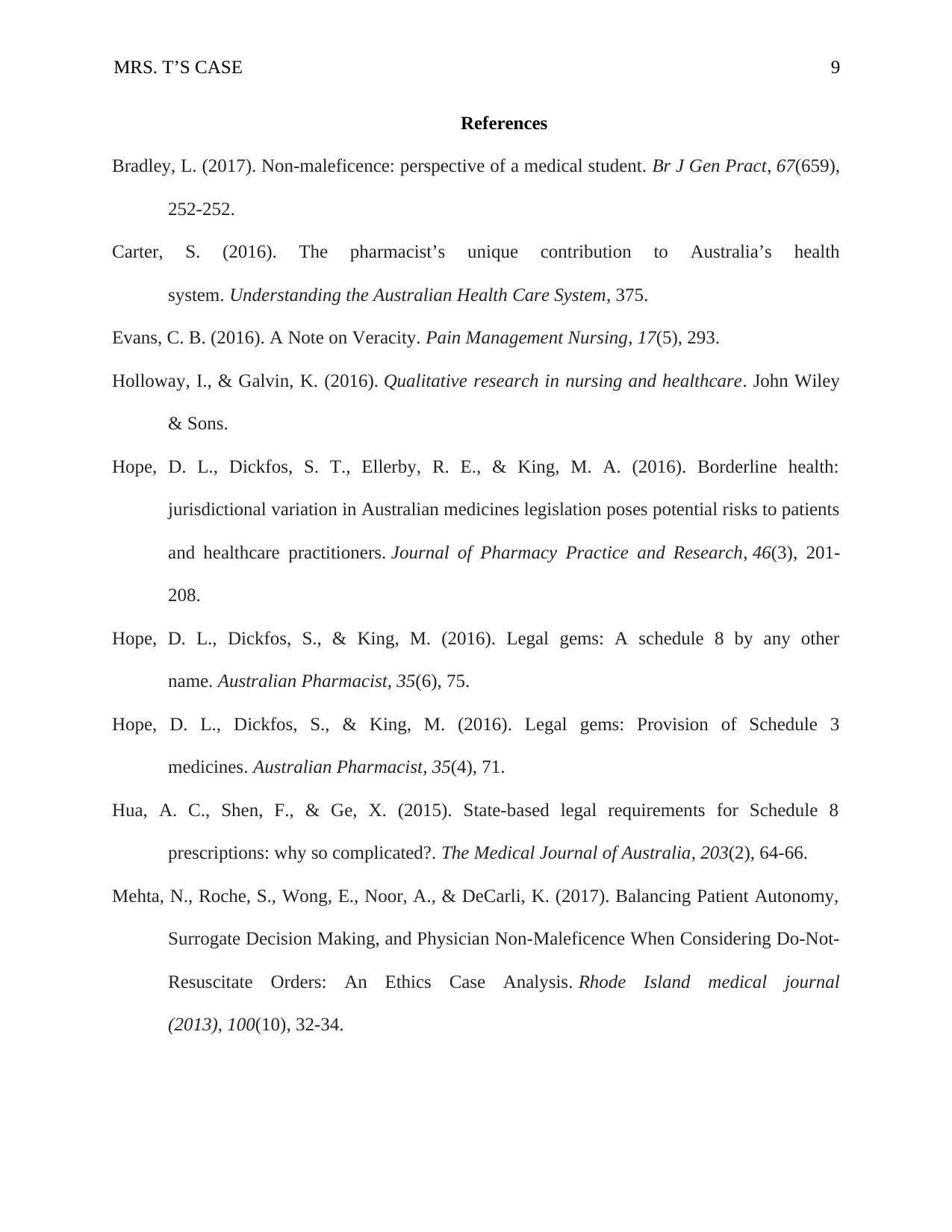
MRS. T’S CASE 9
References
Bradley, L. (2017). Non-maleficence: perspective of a medical student. Br J Gen Pract, 67(659),
252-252.
Carter, S. (2016). The pharmacist’s unique contribution to Australia’s health
system. Understanding the Australian Health Care System, 375.
Evans, C. B. (2016). A Note on Veracity. Pain Management Nursing, 17(5), 293.
Holloway, I., & Galvin, K. (2016). Qualitative research in nursing and healthcare. John Wiley
& Sons.
Hope, D. L., Dickfos, S. T., Ellerby, R. E., & King, M. A. (2016). Borderline health:
jurisdictional variation in Australian medicines legislation poses potential risks to patients
and healthcare practitioners. Journal of Pharmacy Practice and Research, 46(3), 201-
208.
Hope, D. L., Dickfos, S., & King, M. (2016). Legal gems: A schedule 8 by any other
name. Australian Pharmacist, 35(6), 75.
Hope, D. L., Dickfos, S., & King, M. (2016). Legal gems: Provision of Schedule 3
medicines. Australian Pharmacist, 35(4), 71.
Hua, A. C., Shen, F., & Ge, X. (2015). State-based legal requirements for Schedule 8
prescriptions: why so complicated?. The Medical Journal of Australia, 203(2), 64-66.
Mehta, N., Roche, S., Wong, E., Noor, A., & DeCarli, K. (2017). Balancing Patient Autonomy,
Surrogate Decision Making, and Physician Non-Maleficence When Considering Do-Not-
Resuscitate Orders: An Ethics Case Analysis. Rhode Island medical journal
(2013), 100(10), 32-34.
References
Bradley, L. (2017). Non-maleficence: perspective of a medical student. Br J Gen Pract, 67(659),
252-252.
Carter, S. (2016). The pharmacist’s unique contribution to Australia’s health
system. Understanding the Australian Health Care System, 375.
Evans, C. B. (2016). A Note on Veracity. Pain Management Nursing, 17(5), 293.
Holloway, I., & Galvin, K. (2016). Qualitative research in nursing and healthcare. John Wiley
& Sons.
Hope, D. L., Dickfos, S. T., Ellerby, R. E., & King, M. A. (2016). Borderline health:
jurisdictional variation in Australian medicines legislation poses potential risks to patients
and healthcare practitioners. Journal of Pharmacy Practice and Research, 46(3), 201-
208.
Hope, D. L., Dickfos, S., & King, M. (2016). Legal gems: A schedule 8 by any other
name. Australian Pharmacist, 35(6), 75.
Hope, D. L., Dickfos, S., & King, M. (2016). Legal gems: Provision of Schedule 3
medicines. Australian Pharmacist, 35(4), 71.
Hua, A. C., Shen, F., & Ge, X. (2015). State-based legal requirements for Schedule 8
prescriptions: why so complicated?. The Medical Journal of Australia, 203(2), 64-66.
Mehta, N., Roche, S., Wong, E., Noor, A., & DeCarli, K. (2017). Balancing Patient Autonomy,
Surrogate Decision Making, and Physician Non-Maleficence When Considering Do-Not-
Resuscitate Orders: An Ethics Case Analysis. Rhode Island medical journal
(2013), 100(10), 32-34.
⊘ This is a preview!⊘
Do you want full access?
Subscribe today to unlock all pages.

Trusted by 1+ million students worldwide
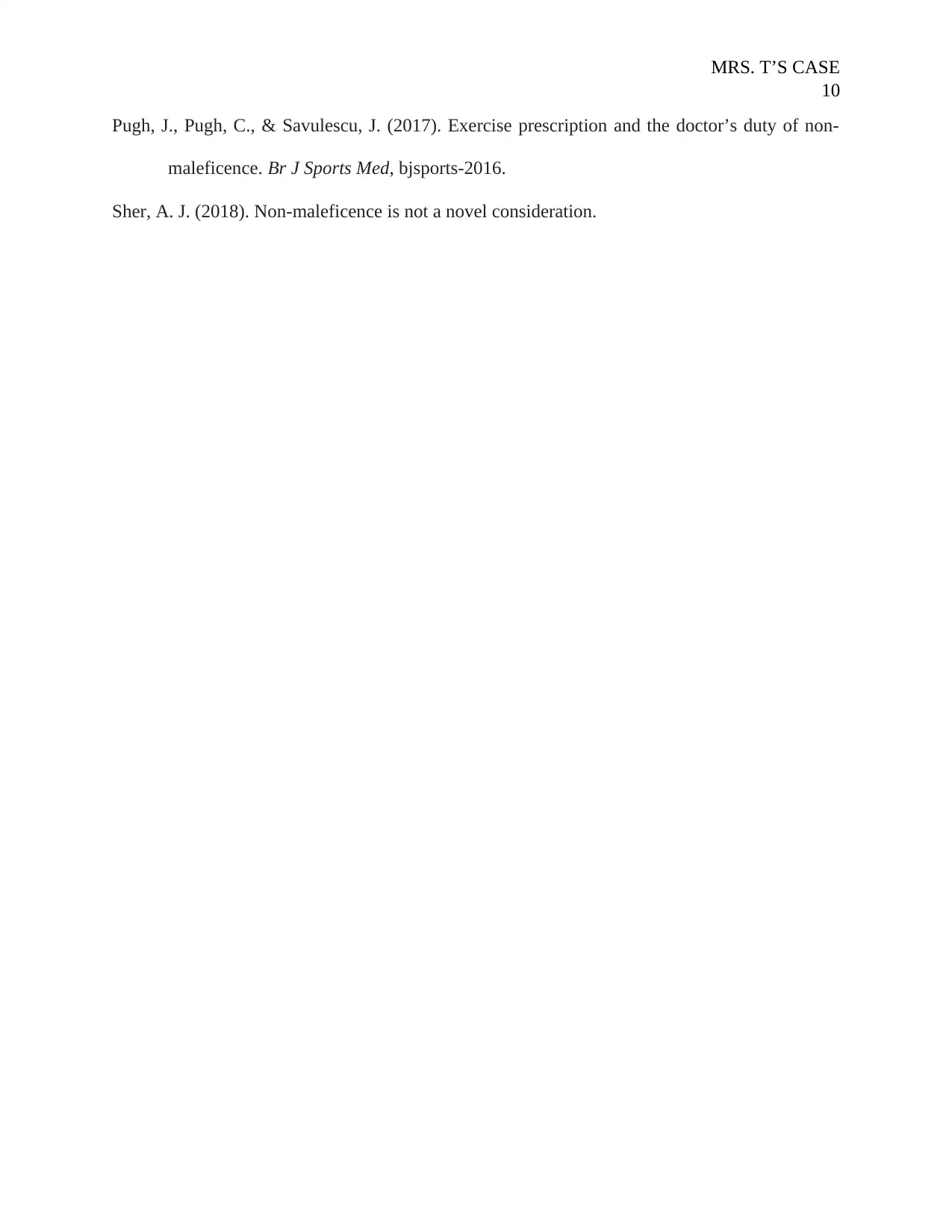
MRS. T’S CASE
10
Pugh, J., Pugh, C., & Savulescu, J. (2017). Exercise prescription and the doctor’s duty of non-
maleficence. Br J Sports Med, bjsports-2016.
Sher, A. J. (2018). Non-maleficence is not a novel consideration.
10
Pugh, J., Pugh, C., & Savulescu, J. (2017). Exercise prescription and the doctor’s duty of non-
maleficence. Br J Sports Med, bjsports-2016.
Sher, A. J. (2018). Non-maleficence is not a novel consideration.
1 out of 10
Your All-in-One AI-Powered Toolkit for Academic Success.
+13062052269
info@desklib.com
Available 24*7 on WhatsApp / Email
![[object Object]](/_next/static/media/star-bottom.7253800d.svg)
Unlock your academic potential
Copyright © 2020–2025 A2Z Services. All Rights Reserved. Developed and managed by ZUCOL.


